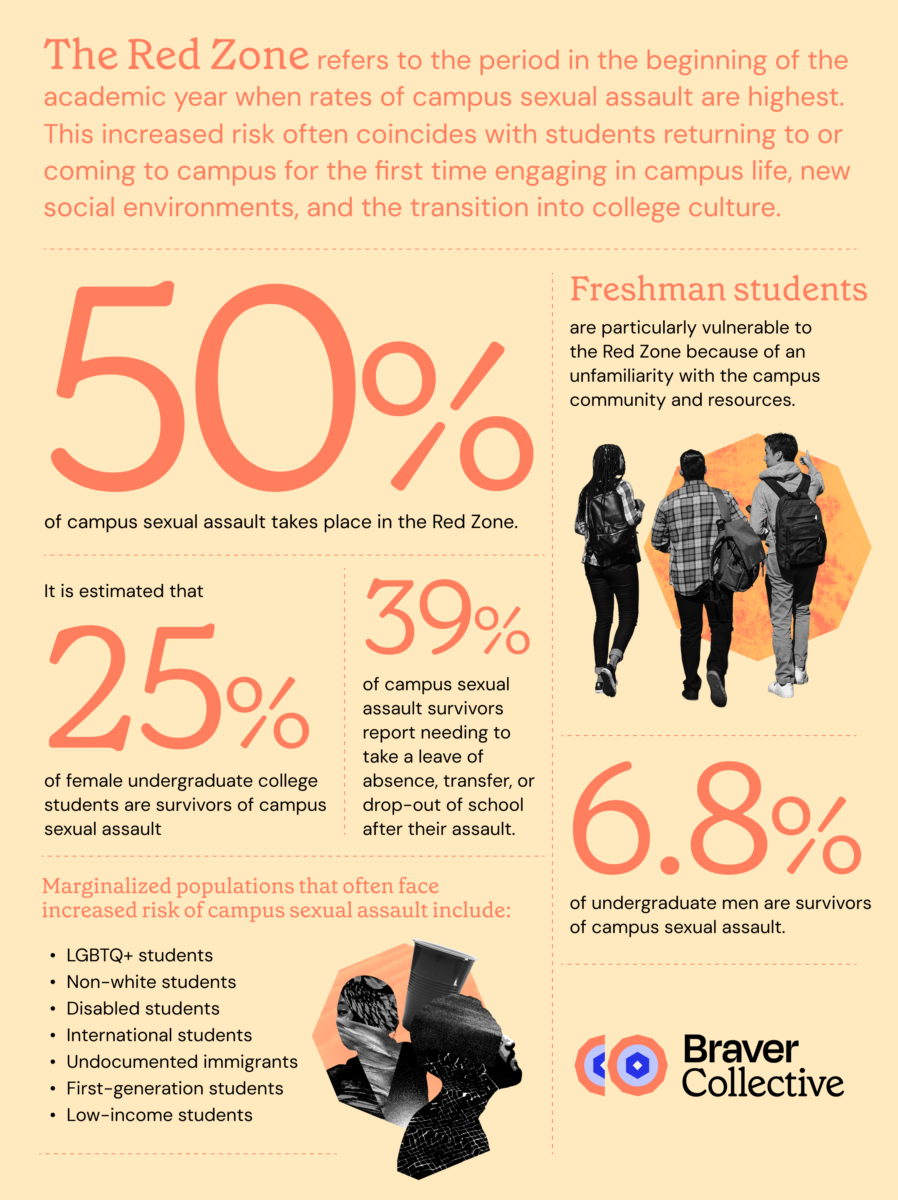Resource
Navigating Campus Sexual Violence
Understanding Title IX, Your Rights, and the Power of Collective Healing
A Promise Broken, But Not Beyond Repair
In 1972, Title IX was enacted to guarantee equal access to education, regardless of sex. For many survivors of campus sexual violence, it became a lifeline–a promise that justice, safety, and dignity could coexist within our schools.
Over time, this law evolved from a legal statute into something more personal–a tool of hope. But as with many systems built by people, Title IX has never been immune to politics. Its protections have been expanded, dismantled, and restored, often leaving survivors caught in the middle.
Today, that pendulum has swung once again. The Trump Administration’s 2025 reversal of key Title IX protections has left countless students wondering: What now?
If you’re a student survivor or an advocate trying to make sense of it all – this piece is for you. Let’s unpack what these changes mean, what options still exist, and how healing and resistance can happen side by side.
What Has Changed – and Why It Matters
During the Biden Administration, reforms were made to strengthen survivor protections. These updates:
- Broadened the definition of sexual harassment to include a wider range of behaviors.
- Eliminated the requirement for live cross-examinations, which often retraumatized survivors.
- Reaffirmed protections for LGBTQIA+ students, particularly transgender, intersex, and non-binary survivors.
But in 2025, many of these reforms were rolled back. Under the reinstated 2020-era policies:
- Schools are not required to investigate incidents that occur off-campus or outside of sanctioned school events.
- Reporting requirements are narrower, meaning fewer cases qualify for formal investigation.
- Live hearings may once again be mandated, even when retraumatizing for survivors.
- Protections for LGBTQIA+ students have been weakened or removed entirely.
These shifts are not just bureaucratic. They have real consequences: Students may once again be forced to tell their stories in a hostile environment. Student survivors of off-campus assaults may be told their trauma “doesn’t count.” And queer and trans students may face new layers of disbelief and discrimination.
What You Can Do: Exploring Your Options as a Student Survivor
If you have experienced sexual violence, harassment, or discrimination on campus, you still have rights. The process may feel confusing – especially as policies change – but you do not have to navigate it alone.
Here are several possible paths, remembering that there is no one-size-fits-all approach to healing or seeking justice.
REPORTING THROUGH TITLE IX
You can still file a formal complaint with your school’s Title IX Coordinator. This option may lead to:
- A school investigation into the accused party.
- Potential disciplinary actions (if policy violations are found).
- Access to accommodations such as class changes, housing adjustments or no-contact orders.
Even if the incident occurred off campus, you can still report – some schools will choose to investigate if the assault affects your educational access or safety.
Tip: Ask your Title IX Coordinator to provide a copy of your school’s sexual misconduct policy. This will outline definitions, timelines, and your rights throughout the process.
CHOOSING NOT TO REPORT – AND PRIORITIZING HEALING
Reporting is not the only way to reclaim power. Many survivors choose not to file formal complaints, and that decision is entirely valid. You may instead wish to:
- Connect with a confidential advocate or counselor on campus.
- Seek support from peer survivor groups, often found through Women’s Centers, LGBTQIA+ centers, or student-led coalitions.
- Access academic or housing accommodations without disclosing the details of your assault.
Schools are still required under Title IX to provide support measures, even if you decide not to file a formal complaint.
EXPLORING OFF-CAMPUS OR LEGAL OPTIONS
If your school’s process feels unsafe or inadequate, you can also:
- File a police report.
- Seek a civil attorney who specializes in Title IX or sexual assault cases.
Each route comes with unique timelines and emotional impacts, so consider what aligns with your personal goals and capacity right now.
Understanding the Red Zone – and Why Timing Matters
The “Red Zone” refers to the first six to eight weeks of the fall semester – the period when over 50% of college sexual assaults occur. This risk is particularly high for:
- First-year students navigating new environments.
- LGBTQIA+ students and students of color.
- Those experiencing housing or financial instability.
- Students who may have previously experienced sexual assault or harassment.

During this time, campus prevention programs, orientations sessions, and peer networks can make a critical difference.
If you are an educator or administrator, consider how you can interrupt the Red Zone:
- Strengthen bystander intervention training.
- Collaborate with local or national survivor organizations.
- Audit campus safety policies for inclusivity and accessibility.
Tools For For Accountability and Awareness
At End Rape On Campus (EROC), we developed the Campus Accountability Map & Tool (CAMT) to make schools’ sexual misconduct policies transparent and accessible.
The CAMT allows students, parents, and advocates to:
- Review how schools respond to sexual assault.
- Compare policies across institutions
- Access contact information for Title IX offices.
- Identify whether a school provides trauma-informed and LGBTQIA+ inclusive support.
By using tools like CAMT, survivors and advocates can make informed choices about where and how to pursue education – and hold institutions accountable for their policies.
Explore the map at endrapeoncampus.org/map-and-tool.

Reclaiming Power in a Broken System
Let’s be honest: the system should not have to rely on survivor resilience. Yet time and time again, it does.
For trans and non-binary survivors, for students of color, for disabled students, for low-income students – the barriers are layered and exhausting. But knowing your rights, accessing support and finding community can become radical acts of resistance.
You are not alone in this fight. Survivors across the country are advocating for:
- State-level protections that extend beyond federal Title IX rules.
- Trauma-informed training for campus investigators and staff.
- Policy reforms led by survivors.
At EROC, we’ve seen firsthand how collective action shifts culture – from campuses that reform their procedures after student organizing, to legislators who listen when survivors testify.
Pathways Toward Healing
Healing after sexual violence is not linear. It may include:
- Therapy or counseling (on or off campus).
- Creative outlets such as art, writing, movement (i.e. dance).
- Community connection, whether through peer groups, spirituality, or activism.
You get to decide what healing looks like. You get to take your time. You deserve spaces that affirm your voice, your truth, and your pace.
If you're unsure where to begin, consider these starting points:
- End Rape On Campus (EROC): Resources, policy advocacy, and direct survivor support.
- Know Your IX: Guides for navigating Title IX and understanding your rights.
- Every Voice Coalition: learn about state-level policies
- The Trevor Project: Support for LGBTQIA+ youth
- It’s On Us: Support for student athletes
- National Alliance to End Sexual Violence (NAESV): Policy and advocacy resources
- National Women’s Law Center: Legal counsel and support resources
A Call to Stay Brave
Title IX is more than a law –it’s a reflection of what we believe students deserve: safety, dignity, and equality. Even as policies shift, our collective power remains.
You can be part of that power by:
- Educating others about their rights.
- Supporting survivor-led organizations.
- Holding your school accountable.
- Taking care of yourself and others through every step.
We’ve fought back before, and we will again. The promise of justice may bend under pressure – but with each survivor who speaks, organizes, or heals out loud, that promise comes back stronger.

